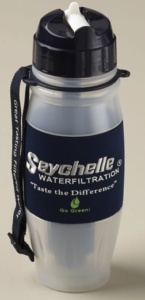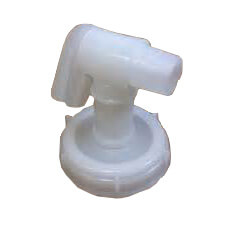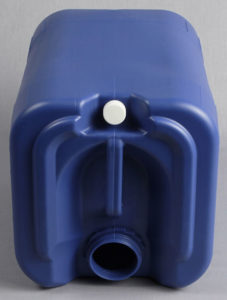Quantity Recommendations
The suggested amount of stored water per person for two weeks is 14 gallons. This does not include water for cooking, bathing, flushing toilets, washing clothes, etc.
72-hour Kit
Store water for 3 days in an easy-to-carry container.
- Bota bag (~$12)
Leather bag with cord-like strap. Comfortable to carry; tends to leak. Bota Bag (Amazon) - Canteen (~$9)
Comes with a strap, belt clip, or belt. Gives a metallic or plastic taste to the water. - Water filtration bottle (~$16-30 Seychelle water bottle, ~$6 replacement filter)
Produces up to 100 gallons of filtered water per replaceable filter. (LDS Home Storage Center or store.lds.org)

Medium-sized Storage
Store water for 2 weeks in an easy-to-evacuate container.
- Two-liter soft drink bottle
- Add 4 drops bleach and store in a dark room.
- Easy to transport.
- 5-gallon jug with spigot (~$11)
- Add ½ tsp. bleach and store in a dark room.
- Convenient for providing “running” water.
5 Gallon Blue Water Storage Container (Industrial Container)
Cap for 5 Gallon Jug
Spigot for 5 Gallon Jug

- Do not use:
- Milk jugs or bottled water jugs made from biodegradable plastic. They leak!
- Containers made from plastic that is not food grade, such as bleach bottles.
- Containers that held toxic products.
Large-sized Storage
- 5-gallon blue, stackable jugs (~$11)
- Easy to move.
- Easy to rotate the water.
5 Gallon Blue Water Storage Container (Industrial Container)

- 55-gallon barrel for longer-term storage (~$48)
- Clean the barrel.
- If new, rinse before using.
- If used for soft drink concentrate, clean thoroughly.
Try the high-pressure hoses at a car wash.
The plastic can give a soda flavor to stored water, but it is not unsafe.
55 Gallon Blue Poly Drum (Industrial Container)

- Add 3½ tsp. bleach.
- Store a hand pump. (~$14)
Siphon/Drum Pumps (Industrial Container)

- Storage locations—the darker the better
- Choose a location carefully—full barrels are too heavy to move!
- Basement
Do not place directly on concrete that can leach chemicals through plastic.
Place wood pieces under the barrels. - Garage or shed
Avoid car exhaust because plastic is semi-permeable.
Place a plywood sheet over four barrels to make a workbench. - Outdoors
Allow space in barrels for expansion from winter freezing.
Keep out of the sun to avoid microbial or algae growth and plastic deterioration.
- Replace water every 2-3 years.
Other Sources for Water Storage
- Water heaters, toilet tanks, and household pipes
- Know where the water shut-off valve is located for your house.
- Turn the shut-off valve immediately upon learning of a problem with the community water system—before the water in your pipes and water heater can drain out or become contaminated.
- Do not open the valve again until proper purification measures are taken by the community: super chlorination for one day, or moderate chlorination for three days. All community water systems have some cracks in the pipes that allow contamination to flow back into the system when the water pressure is interrupted.
- Washing machines and bathtubs
Fill washers and tubs when an emergency is expected. - Swimming pools and waterbeds
- Follow proper purification measures before drinking.
- Keep covered to decrease exposure to contamination.
Water Purification
- During a disaster, assume that any water not stored or purchased is contaminated.
- Ideally, contaminated water should be:
- Filtered for large debris,
- Filtered for particles and microbes,
- Boiled or chemically treated,
- Filtered again to remove chemical taste.
Filtration Methods
- Filter out large debris using coffee filters, cloth, paper towel, etc.
- Filter out particles and microbes using a commercially manufactured filter.
- 72-hour kit: small backpack filter (filters at the microbial level, or filters and adds a chemical)
- Personal filter straw—filters 20 gallons (Aquamira, LifeStraw) (~$10-20)
- Water filtration bottle (~$16-30 Seychelle water bottle, ~$6 replacement filter)
Filters as you drink, removing over 99.99% of bacteria, viruses, chemicals, and heavy metals. Produces up to 100 gallons of filtered water per replaceable filter. (LDS Home Storage Center or store.lds.org) - Pump filters—can produce 1 gallon/minute (Katadyn) (~$75-90)
Katadyn Hiker Pro Transparent Water Microfilter (Amazon)
- Distillation (see Boy Scout field book)
- Evaporate water to remove it from the contaminants.
- Collect the evaporated water with clean equipment.
Purification Methods
- Boiling—recognized as the safest treatment method.
- Bring to a rolling boil for a minimum of 10 minutes.
Add one minute for every 1,000 feet above sea level. - Cover with a lid or use a pressure cooker to shorten the time.
- Bring to a rolling boil for a minimum of 10 minutes.
- Purifier—a commercially manufactured filter that is fine enough to remove bacteria and viruses (Big Berkey, ProPur) (~$185+).
- Evaluate cost, filtration of microbes, and quantity of water filtered.
- Store replacement filters.
Big Berkey BK4X2 Countertop Water Filter System (Amazon)
- Chemicals—added to destroy bacteria and viruses.
- Chlorine bleach
Must contain at least 5.25% or 6% sodium hypochlorite.
Must NOT contain detergents, scent, phosphates or any additive.
Mix the chlorine and water and let stand for 30 minutes.
1 gallon water + ⅛ tsp. bleach
5 gallons water + ½ tsp. bleach
55 gallons water + 3½ tsp. bleach
Bleach loses half its strength in one year, so double the quantity when using old bleach.
Chlorine taste can be removed by opening the container and allowing the chlorine to evaporate after the 30-minute treatment time. - Granular calcium hypochlorite (swimming pool shock) (Poolife Turboshock 78%) (~$6)
Granular calcium hypochlorite stores indefinitely without losing strength if kept dry.
Wear goggles and gloves when handling.
EPA instructions:
Dissolve ¼ ounce (or 1 heaping tsp.) in 2 gallons water to reconstitute a stock chlorine solution.
Combine 1 part stock chlorine solution to 100 parts water (2 cups stock chlorine solution + 12.5 gallons water)
Allow to stand 30 minutes and aerate the water as when using chlorine bleach. - Iodine
2% tincture or topical solution
Iodine is light sensitive and must be stored in a dark bottle.
Mix the iodine and water and let stand for 30 minutes.
1 gallon water + 12 drops iodine
Double the iodine and the waiting time for cloudy water.
Iodine leaves an objectionable taste (although still safe) that can be removed by adding ascorbic acid (vitamin C) or a neutralizer tablet after the 30-minute treatment time.
Iodine is not recommended for people with iodine allergies, people with thyroid problems, people taking lithium, and pregnant women. - Iodine tablets (Potable Aqua, Coghlan’s) (~$10/50 tablets)
Iodine tablets have an indefinite shelf life when sealed in the original bottle, but manufacturers recommend three years. Tablets change color from gray to brown as they lose iodine. Water should have a brown tint after treating.
Mix the tablet and the water and let stand for 30 minutes.
1 quart water + 1 tablet
Double the tablets and waiting time for cloudy or cold water.
Neutralizer tablets are often included to eliminate iodine taste. - Chlorine dioxide tablets (Micropur) (~$10/30 tablets)
Chlorine dioxide tablets are effective against viruses and bacteria in 15 minutes, Giardia in 30 minutes, and Cryptosporidia in 4 hours.
Treated water tastes fresh and remains bacteria free for up to 6 months.
Tablets have a shelf life in excess of 5 years while sealed. - Other products that can be used for water purification include chlorine tablets (Halazone), liquid colloidal silver, and hydrogen peroxide.
- Chlorine bleach
Taste
- To improve the taste of chemically treated water, run the water through a filter.
- To improve the taste of any treated water, pour the water from one clean container to another several times. This process will oxygenate the water and remove some of the flat taste.
- Clean the barrel.